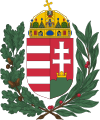Sándor Wekerle
Sándor Wekerle | |
|---|---|
| Prime Minister of the Kingdom of Hungary | |
| In office November 17, 1892 – January 14, 1895 | |
| Preceded by | Gyula Szapáry |
| Succeeded by | Dezső Bánffy |
| In office April 8, 1906 – January 17, 1910 | |
| Preceded by | Géza Fejérváry |
| Succeeded by | Károly Khuen-Héderváry |
| In office August 20, 1917 – October 30, 1918 | |
| Preceded by | Móric Esterházy |
| Succeeded by | János Hadik |
| Personal details | |
| Born | November 14, 1848 Mór, Hungary |
| Died | August 26, 1921 (aged 72) Budapest, Hungary |
| Profession | Jurist, Politican |
Sándor Wekerle (November 14, 1848 – August 26, 1921) was a Hungarian politician who served three times as prime minister.
He was born in Mór, in the comitatus of Székesfehérvár. After studying law at the University of Budapest he graduated doctor juris. He then entered the government service, and after a period of probation was appointed to a post in the ministry of finance. He still, however, continued an academic career by lecturing on political economy at the university.
In 1886 Wekerle was elected to the House of Deputies, became in the same year financial secretary of state, and in 1889 succeeded Kálmán Tisza as minister of finance. He immediately addressed himself to the task of improving the financial position of the country, carried out the conversion of the State loans, and succeeded, for the first time in the history of the Hungarian budget, in avoiding a deficit.
In November 1892 Wekerle succeeded Count Gyula Szapáry as premier, though still retaining the portfolio of finance. At the head of a strong government he was enabled, in spite of a powerful opposition of Catholics and Magnates, to carry in 1894 the Civil Marriage Bill. The continued opposition of the clerical party, however, brought about his resignation on the 22nd of December 1894, when he was succeeded by Dezső Bánffy. On January 1, 1897 he was appointed president of the newly created judicial commission at Budapest, and for the next few years held aloof from politics, even under the ex-lex government of Khuen-Héderváry. On the reconciliation of the king-emperor with the coalition he was therefore selected as the most suitable man to lead the new government, and on April 8, 1906 was appointed prime minister, taking at the same time the portfolio of finance. He resigned the premiership on April 27, 1909, but was not relieved of his office until the formation of the Khuen-Héderváry cabinet on January 17, 1910.
Wekerle returned to power in 1917, and served for the last year of the First World War. As in his 1906 to 1910 ministry, Wekerle was largely acting as a figurehead for a coalition of stronger personalities around him. Although, towards its end, the ministry began to move in the direction of an expansion of the Hungarian franchise, events, particularly the imminent military defeat of Austria-Hungary and its allies, moved too fast for it, and Wekerle resigned in October 1918.
In the south of Budapest, the notable Wekerle estate (Wekerletelep) neighbourhood is named after him. Built before World War II, its central square was designed by the architect Károly Kós. The neighbourhood provided affordable housing to working class families in a green, open and familiar setting. This was an early example of a planned residential neighbourhood in Europe.
- This article incorporates text from a publication now in the public domain: Chisholm, Hugh, ed. (1911). Encyclopædia Britannica (11th ed.). Cambridge University Press.
{{cite encyclopedia}}: Missing or empty|title=(help)

